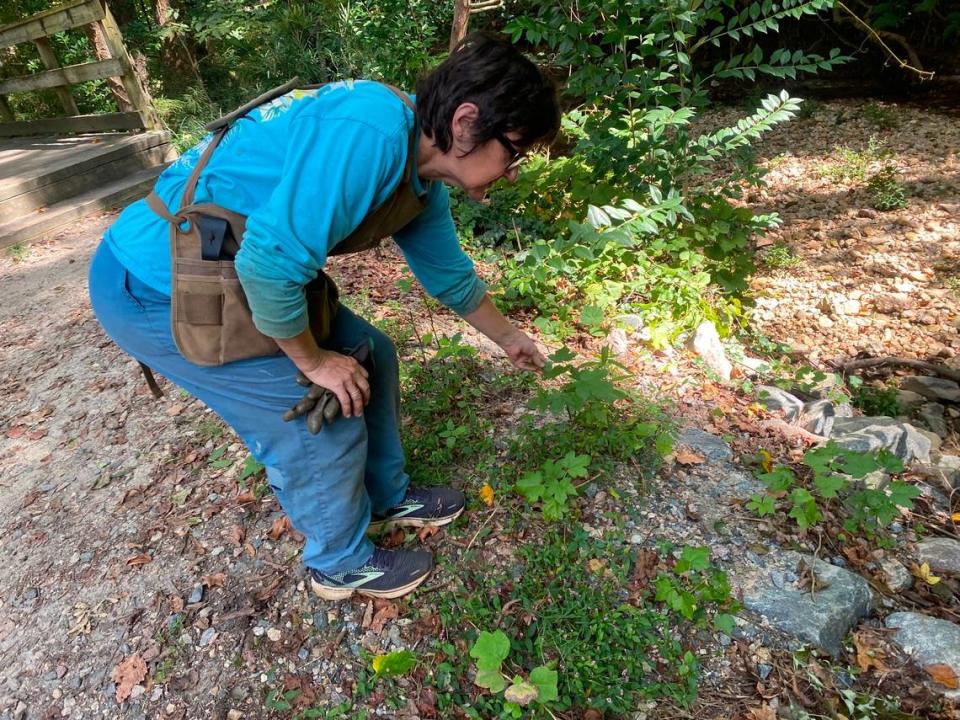She’s on a crusade to rid Raleigh of invasive plants. The ivy doesn’t stand a chance.
About a year ago, Kate Dixon noticed how the English ivy was strangling her neighborhood greenway, snaking up the oak trees and blocking out the light.
So newly retired Dixon asked the city whether she could tackle the vine choking the Windemere Beaver Dam trail — armed with a pair of loppers and a foldable saw.
“They were like ‘Go for it,’ “ Dixon said. “I think they didn’t know quite how obsessive I was.”
Since September of 2022, Dixon has led a mostly one-woman crusade against invasive plants in her neighborhood off Wade Avenue, recruiting a handful of similarly dedicated volunteers.
And in that time, Dixon’s crew has piled up, by her guess, more than 10,000 pounds of yard-waste debris for the city to haul away. And that’s only a few blocks’ worth.
She knows a good plant from a bad one
Working almost every day, she has hacked through vines as thick as a human arm, leaving the scraggly remains to turn brown on the tree trunks. A single tree required four hours of work to get completely ivy-free.
Dixon has yanked up plants by the root, and now she notices hickory and sassafras growing taller.
“There’s no way the city could hire enough staff to get this done,” she said. “I could do nothing but English ivy and that would be helpful.”

Dixon brings a long history of conservation to the job, retiring as executive director of Friends of the Mountains-to-Sea Trail and heading Triangle Land Conservancy before that.
So she knows a good plant from a bad one.
But since 2015, Raleigh has drawn nearly 5,000 volunteers into its invasive species program, adding more than 13,000 hours of work.
The city doesn’t want people going out into parks and cutting plants willy-nilly. An organized workday is scheduled on the Windemere Beaver Dam trail in November, and the city asks would-be ivy-cutters to watch for events across Raleigh on its webpage to get their start.
The NC Invasive Plant Society lists more than 60 non-native trees, shrubs and vines in North Carolina’s Piedmont region, including kudzu and mile-a-minute vine.
The damage invasive plants do
The group estimates more than $34 billion gets spent nationwide each year fighting invasives, which can choke out native plants, destroy wildlife habitat and, in the cast of English ivy, create breeding ground for mosquitoes.
Off Wade Avenue, the greenway runs along Banbury Road, stretching only 20 or 30 feet across in most places, making it easier to clear. Still, Dixon heads out with her loppers for about 15 hours a week.
“Kate doesn’t just say ‘That would be nice,’ “ said Amy Mackintosh, a neighbor and leader with the NC Native Plant Society. “Kate goes out and works 15 hours a week. I don’t think most volunteers are as avid. But it’s galvanized others of us to do more than we would have done.”
In the woods Dixon has worked, the creek is now far more visible for walkers, and plants like jack-in-the-pulpit have started to show themselves. She pointed to an oak recovering from an ivy infestation, its branches still slightly squashed.
“The reason it looks so deformed is it was held down by ivy,” she said. “That’s a year’s worth of improvement.”
The city is hiring an invasive species coordinator soon, and Dixon hopes that a coordinated attack can start on greenways across Raleigh.
A few dozen more set of loppers can let in a lot more light.

